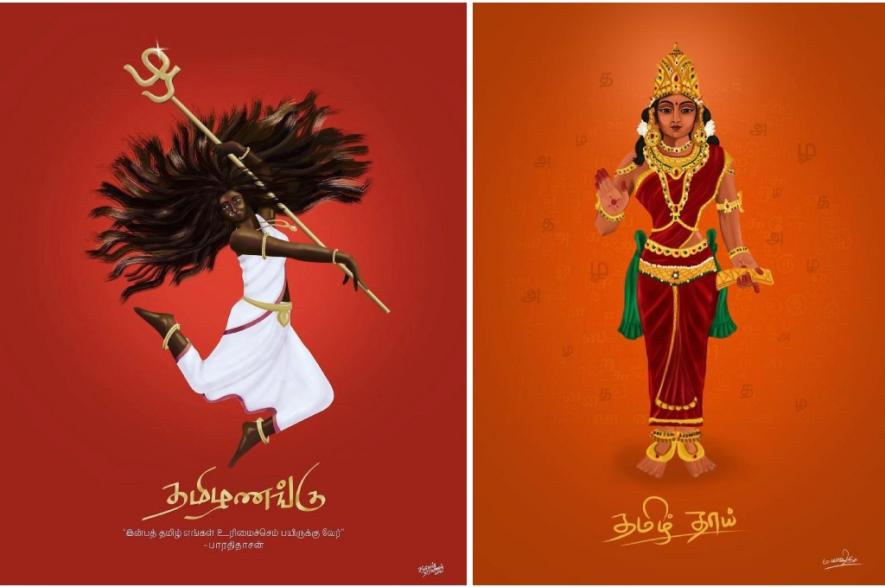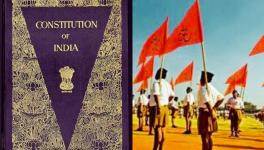Two Portraits of Tamil: Decoding the Iconography, Identity, and Ideology

[Editor’s note: The ruling dispensation’s push to homogenise culture and impose one above all others has been relentless. In this iconographic analysis, the author highlights what happens when there is an attempt to impose one culture on another.]
On April 9, 2022, Oscar-winning music director AR Rahman tweeted a picture titled “Tamilanangu” (“Warrior Tamil Girl”). His tweet went viral and was retweeted by Tamil enthusiasts all over the world.
Two days before Rahman’s tweet, the Committee of Parliament on Official Language held its 37th meeting in Delhi. The Home Minister Amit Shah, presiding over the Committee, stated that “the time has come to make the official language an important part of the unity of the country”. He added that Hindi would be made compulsory up to Class 10 in the Northeastern states of India. His speech immediately drew severe criticism. It is in this context that AR Rahman, “the Mozart of Madras”, made a powerful statement by sharing the Tamilanangu portrait.
A month later, the same picture was shared by Tamil Nadu Chief Minister MK Stalin to celebrate the performance of the state anthem at the Vatican. In response, K Annamalai, the BJP Tamil Nadu president, tweeted another personification of Tamil. This one was entitled “Tamil Thai” (“Tamil Mother”). BJP cadres lauded the latter iteration as a dignified representation of Tamil.
What are the hidden symbolisms in these two images? How does each portrait present its political ideology?
Decoding the Iconography
Iconography, in simple terms, is the use of images and symbols to represent ideas by a religious or political group. In this case, the posture, clothing, and ornamentation of the two images reveal specific ideological leanings.
Tamil Thai strikes a feminine pose, one that is acquiescent and conformist. Her lowered eyes do not gaze directly at the viewers, or their existential struggles. Her feet remain affixed, perhaps enchained by the weight of traditions. Her timid posture does not inspire the Tamils in their bold struggle against hegemonic structures. Her submission and conformism nudge Tamils to lay down their resistance.
In contrast, Tamilanangu radiates an aggressive, fierce, combative force that is synonymous to her name Anangu – a reference to Kottravai, the ancient Tamil personification of war. Her eyes remain focused on the horizon, conveying her vigilant attitude. She wields the classic Tamil weapon, the Vel or spear, with the unique Tamil letter ழ (zha). Perhaps the metaphorical war she wages is in defense of the language. Her unkempt hair flows around her, magnifying the ferocity of her posture. Overall, her dynamic posture shatters conventions, and presents a gripping image of a warrior passionately defending her heritage and its future.
The BJP’s Tamil Thai adorns herself in a silk saree with golden embroidery. Her necklaces and amulets, her elongated earrings, bangles, anklets, and the intricate girdle with profuse golden embellishment, combine to create an image of extravagant opulence. Her towering crown, studded with precious stones, evokes the image of an empress. Such a lavish portrayal effectively distances her from commoners. She seems to be self-indulgent, enjoying luxury while her people struggle for survival. This may also suggest a pernicious feudal mindset that those impoverished masses exist to serve her, not vice versa.
In comparison, the clothing and ornaments of Tamilanangu are minimalistic, yet rich in progressive symbolism, with subtle intertextual cues to Tamil classical literature. The first thing we notice is her modest, plain white cotton saree. Brahmanical tradition demands that widows should wear white clothes; through her proud and deliberate choice of such a saree she crusades against such dehumanization. Also, her choice of ornaments denote simplicity. In particular, the silambu (anklets) transport us to the Tamil classical Silappadikaram (The Epic of the Anklet) in which the woman protagonist holds the erroneous Pandya king to justice. Here is a rather striking cue that Tamilanangu would resist injustice and be the champion of the downtrodden.
Identity Assertion
Identity is the distinct quality or characteristics of a particular population of people, in this case Tamils. I want to highlight the perception of linguistic identity as well as racio-religious identity in these two portraits.
Tamilanangu flaunts her identity boldly with the audacious display of ழ zha (a retroflex approximant that appears as the last letter of Tamizh / தமிழ்). This unique Tamil linguistic identity has been preserved through cautious resistance against external forces, and an ongoing internal linguistic customization. She is not just the keeper of the past, but a vigilant observer of the present, and a crusader for the future. However, the BJP’s Tamil Thai exhibits a bland generic identity, lacking originality and uniqueness. A bunch of empty palm leaves in her hand hardly evokes any linguistic pride. Even the title, Tamil Thai, is carelessly misspelt. In the background, a northern letter ஸ (sa) has been sneaked into the Tamil alphabet. It reveals that the BJP’s actual goal is the dilution of Tamil linguistic identity and its subjugation under Hindi/Sanskrit.
Tamilanangu is dark-skinned, immediately identifying her with this very soil, with the native Dravidian race. She displays her racial identity with elegant grace. Her long loosely worn saree remains reminiscent of the distinctive style of clothing worn by Tamil women. But the BJP’s Tamil Thai seems to have nothing in common with this soil: her pale complexion distances her from most of the people of the soil. Her clothing places her in the company of her northern counterparts. Her racial affinity is strikingly Aryan, disconnected from the land, its people, and its core racial identity.
Also, the BJP’s Tamil Thai appears aggressively agenda-driven. If the Tamil letters are removed from the background of the image, she would effortlessly blend into the Hindu pantheon of gods. The BJP has baptized Tamil Thai in saffron, as if she belongs only to those with a similar religious outlook. Tamilanagu, on the contrary, appears to be a folk hero, adorning herself in white, a colour that the people of various religions can relate to. Probably she has not forgotten how erudite intellectuals across religious traditions composed timeless epics in her honour. She embraces all, staunchly inclusive.
Art for Art’s Sake?
Art can become an unscrupulous weapon in the hands of the ruling elites; it can be wielded to protect the dominant order. This ideological approach to art critiques the naïve notion that art is mere aesthetic expression.
The BJP and RSS are known for the provocative slogan: One nation, one language, one religion. Though presented as a uniting idea, it is exclusivist and divisive, and a majoritarian principle. Its core emphasis on “one nation” weakens the federal structure and disadvantages regional identities; “one language” disproportionately favours Hindi at the cost of local languages; and “one religion” polarizes Hindus against religious minorities. The BJP’s Tamil Thai echoes their distorted ideals of supremacy, patriarchy, and misogyny. Her compliant demeanour calls on the Tamils to embrace the saffron agenda. The profuse regressive symbolisms in her emasculated iconography reveal the BJP’s daring machination to reshape Tamil identity after their ideology. Hers is the ideology from above, coming down from her Northern taskmasters.
On the other hand, the Tamilanangu portrait captures the essence of Tamil heritage, and the indigenous Dravidian ideology that stands for secular ideals. She celebrates the ideals of equality and brotherhood, unlike the other that holds on to hierarchy and hegemony. Her mission is to facilitate social cohesion and joyful coexistence in a progressive society, unlike the other that thrives on social polarization, and perpetual antagonism against the minorities. Hers is the ideology from below, organically emerging from the commoners.
The caption under Tamilanangu reads as follows: “This delightful Tamil is the very root that holds our rights together.” It proclaims that the Tamil people’s rights are intrinsically connected to Tamil. In a sense, in view of the depiction of Tamil in this portrait, it is a battle-cry, reminding the haughty rulers to educate themselves of the long history of linguistic resistance in the Dravidian heartland. However, BJP’s Tamil Thai was tweeted with a short message: “In every direction, Tamil’s grand fame spreads its fragrance.” This line is taken from Tamil Nadu’s official “Invocation to Tamil.” The BJP’s track record in the actual promotion of regional languages, including Tamil, is rather dismal. Tamil has grown and spread its fame not because of BJP, but despite their active ploy to limit its fame.
Language is a powerful tool; a tool that can either be used for liberation and transformation, or for domination, and spreading superstitions; ideological vision drives its direction. Iconographic representations embed them in public attitude, forming collective identities that last through generations. The BJP’s ideology is obvious as it attempts to engineer a submissive outlook in Tamils before northern supremacy.
Tamilanangu stirs the collective Tamil conscience to rise against the tide of saffronisation. Having personified the Tamils’ aspiration for autonomy and social transformation, she towers over the BJP’s puppet version of Tamil Thai, resembling Kottravai amid war, a scenario not unlike the current situation in India. Through the strength of her inimitable virtue and resilience, she empowers her people to triumph over the engulfing saffron darkness.
D Gnanaraj is an ardent Tamil enthusiast interested in learning Tamil history and its classics and observing current socio-political trends and trajectories. He is a native of Thuckalay, Tamil Nadu. He completed doctoral studies in South Korea and currently resides there. He is also a member of Korea Tamil Sangam, a vibrant organisation that brings the Tamils in Korea together through various activities.
Get the latest reports & analysis with people's perspective on Protests, movements & deep analytical videos, discussions of the current affairs in your Telegram app. Subscribe to NewsClick's Telegram channel & get Real-Time updates on stories, as they get published on our website.























